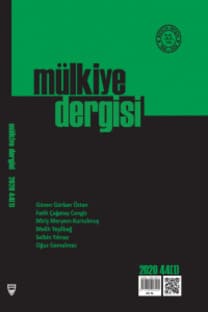Yeni İletişim Teknolojileri, Alternatif İletişim Olanakları
Her yeni iletişim teknolojisi, alternatif medya tartışmalarını yeniden gündeme taşımaktadır. İnternet ya da genel olarak yeni iletişim teknolojileri de yaygın kullanılmaya başlandıkları 90’lı yılların ortalarından sonra aynı tartışmanın yeniden gündeme gelmesine neden olmuştur. Bugün, internet üzerinde video paylaşım siteleri, haber temelli başka uygulamalar, sosyal paylaşım siteleri, bloglar, haber grupları ya da tartışma listeleri şeklinde sıralanabilecek pek çok iletişim platformu oluşmakta ve kendilerini ifade etmek için bu tür platformları kullanmayı tercih eden insanların sayısı da hızla artmaktadır. Genel olarak bu deneyimlerin hepsi, alternatif medya tartışmalarını yeniden başlatan, bu arada yurttaş medyası, katılımcı medya, etkileşimli gazetecilik, halk gazeteciliği, radikal medya gibi çeşitli kavramların ortaya çıkışına neden olan deneyimler olarak akademik ilgiyi hak ediyor olsalar da, teknolojik değişim temelli bu alternatif medya tartışmalarını aşan bir kavramsallaştırmaya ihtiyaç olduğu söylenmelidir. Teknolojik değişim ve iletişim deneyimlerinin farklılaşması arasında nasıl bir ilişkisellik kurulabileceği bu kavramsallaştırma çabasının en önemli uğraklarından birisidir. Bu çalışmada internetin neden olduğu teknolojik değişim süreci ele alınarak, bu süreçte iletişim deneyiminin farklılaşmasının nasıl kavranması gerektiği tartışmaya açılacaktır.
Anahtar Kelimeler:
Enformasyon ve İletişim Teknolojileri, İnternet, Alternatif İletişim, Alternatif Medya
New Communication Technologies, Possibilities of Alternative Communication
Each new communication technology set a new discussion about alternative media. The Internet or generally new communication technologies brought forth the same debate in the second half of the 90’s when they were started to be commonly used. At the present time, various communication platforms in forms of video sharing websites, news based applications, social networks, blogs, news groups or discussions lists are being formed on the Internet and the number of people using these platforms to express themselves is increasing rapidly. Although all these experiences, that triggered again alternative media discussion and gave rise to a range of concepts such as citizen media, participatory media, interactive journalism, people journalism, radical media, deserve academic interest, what is needed is a conceptualization different than this alternative media discussions based on technological change. One important feature of this conceptualization attempt is the kind of relationship between technological change and differentiation of communication experiences. In this article, the process of technological change engendered by the Internet will be interrogated and the way of conceptualizing the differentiation of communication experience during this process will be discussed.
Keywords:
Information and Communication Technologies, Internet, Alternative Communication, Alternative Media,
___
- Adaklı, Gülseren (2007) “Patterns of Internet use in the context of the rising nationalism in the Turkish society”, The Good, The Bad and The Unexpected: The user and the future of information and communication Technologies, COST Action 298, Moskova, 23-25 Mayıs.
- Ansal, Hacer (1986). “Teknolojinin taraflılığı ve üretim ilişkileri”, Onbirinci Tez Kitap Dizisi, S.1, s.152-171.
- Atton, Chris (2002). Alternative Media, Londra: Sage. Atton, Chris (2003). “What is ‘alternative’ journalism?”, Journalism, C.4, S.3, s.267–272.
- Bailey, Olga Guedes, Bart Cammaerts ve Nico Carpentier (2007). Understanding Alternative Media, Maidenhead: Open University Pres.
- Baran, Paul (1964). “On Distributed Communications: XI. Summary Overview”, http://www.rand.org/ pubs/research_memoranda/2006/RM3767.pdf (Erişim Tarihi: 19.09.2010)
- Başaran, Funda (2010). “Direniş Alanından Canlı Yayın”, http://www.sendika.org/yazi.php?yazi_ no=29364 (Erişim Tarihi: 21.02.2010)
- Başaran Özdemir, Funda (2009). “Alternative Communication on Internet in Turkey” The Good, the Bad and the Challenging: The user and the future of information and communication technologies,
- 35 Raymond Williams (1974). Television: Technology and Cultural Form, Londra: Collins, s.130.
- 36 Ansal (1986) s.152-171.
- 37 Aktaran Arthur Kroker (1984). Technology and the Canadian Mind: Innis/McLuhan/ Grant. Kanada: New World Perspectives, s.123.
- COST Action 298, Kopenhag, 13 – 15.Mayıs. Carpentier, Nico (2009). “Participation Is Not Enough: The Conditions of Possibility of Mediated Participatory Practices”, European Journal of Communication, C.24, S.4, s.407-420. Couldry, Nick ve James Curran (2003). Contesting Media Power: Alternative media in a Networked World, Maryland: Rowman and Littlefield Publishers.
- Downing, John D. H. (2001). Radical Media: rebellious communication and social movements. ABD: Sage Publications Inc.
- Eyerman, Ron ve Andrew Jameson (1991). Social Movement: a Cognitive Approach, ABD: Polity Pres. Flanagin, Andrew J., Wendy Jo Maynard Farinola, and Miriam J. Metzer (2000). “The Technical Code of the Internet/World Wide Web”, Critical Studies in Media Communication, C.17, S.4, s.409-428.
- Innis, Harold A. (1986). Empire and Communications, Kanada: Press Porcepic Ltd.
- Jahandarie, Khosrow (1999). Spoken and Written Discourse: A Multi-disciplinary Perspective, Stamford: Ablex.
- Kroker, Arthur (1984). Technology and the Canadian Mind: Innis / McLuhan / Grant, Kanada: New World Perspectives. Lyytinen, Kalle ve John L. King (2002). “Editorial: Around the Cradle of the Wireless Revolution: the Emergence and Evolution of Cellular Telephony”, Telecommunications Policy, C.26 S.3-4, s.97-100. Mowery, David C. ve Timothy Simcoe (2002). “Is the Internet a US Invention? An Economic and Technological History of Computer Networking”, Research Policy, C.31, S.8-9, s.1369-1387.
- Paulussen, Steve, Ari Heinonen, David Domingo, vd. (2007). “Doing It Together: Citizen Participation In The Professional News Making Process”, Observatorio (OBS*) Journal, C.1, S.3, s.131-154. Rai, Arun, Thiagarajan Ravichandran ve Subhashish Samaddar (1998). “How to Anticipate the Internet’s Global Diffusion”, Communications of the ACM, C.41, S.10, s.97-106. Roberts, Lawrence G. (2000). “Packet Switching or Optical Switching”, IEEE Internet Computing, C.4, S.1, s.50-51.
- Soules, Marshall (1996). “Harold Adams Innis: The Bias of Communications & Monopolies of Power”, http://records.viu.ca/~media113/innis.htm (Erişim Tarihi: 17.09.2010)
- Stevenson, Nick (2002). Understanding Media Cultures, Londra: Sage.
- Williams, Raymond (1974). Television: Technology and Cultural Form, Londra: Collins.
- Williams, Raymond (1989). 2000’e Doğru, İstanbul: Ayrıntı Yayınları.
- Winner, Langdon (2001). “Where Technological Determinism Went?”, Cutcliffe, S.H. ve Mitcham, C. (der.), Visions of STS: Counterpoints in Science, Technology, and Society Studies, Albany: State University of New York Press içinde, s.11-18.
- ISSN: 1305-9971
- Yayın Aralığı: Yılda 4 Sayı
- Başlangıç: 1965
- Yayıncı: Mülkiyeliler Birliği Genel Merkezi
